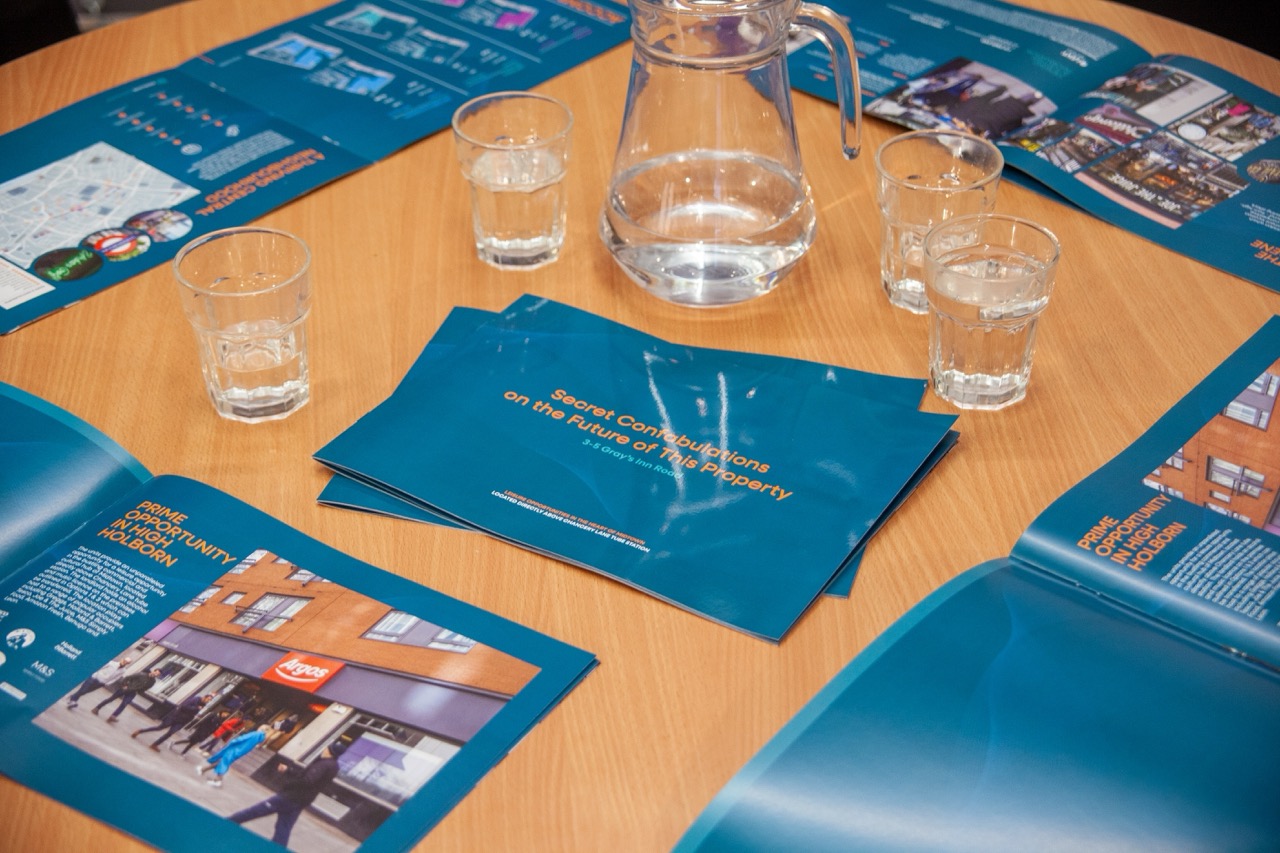


Secret Confabulations on the Future of This Property (2025)


Secret Confabulations on the Future of This
Property (2025). Table, chairs, tumblers, water jug, brochures,
vinyl banner on stand. Variable Size
Secret Confabulations on the Future of This Property is a performative artwork that culminates in a staged photograph and installation. It aims to sarcastically expose the hidden mechanisms of urban regeneration by inviting those who genuinely inhabit a space to decide its future in a meeting. The work is site-specific, exhibited in the very building the participants discuss about during the confab (a space they have directly experienced, whether as studio residents or as a former retail worker) and which now also functions as the exhibition site.
Price: to rent £150,000 per annum exclusive.



I’ve been a resident artist and guest at 5 Gray’s Inn Road
for about 1 year now. This space is currently a gallery and an artist’s studio
divided across two large open floors, the basement used as artist studios and
the ground floor used as an exhibition space. Before an art space, it used to
be an Argos for more than 30 years. A still-existing British retail chain that
has seen the years before Amazon, when people had to leave their houses to buy
its stuff. And has seen the years before the pandemic, when people couldn’t leave
their houses to buy its stuff.
I’ve always been fascinated by these kinds of spaces in London. Places like Hypha, Koppel, and now XYZ. Art charities or organisations that use buildings temporarily, just before they become something else. You live there for a while, suspended in between what the place was and what it will be. Most of the time, as a resident of these spaces, you have no idea what the space used to be, and even less idea what it’s going to become. But you’re there, to make art. Because you’re an artist. “That’s the most important thing”. The future of these places becomes this distant thing. It’s not for you to know. It’s not your business. Those who decide what happens next are far away, emotionally and physically, from the people who actually spend time in these spaces.
I’ve always been fascinated by these kinds of spaces in London. Places like Hypha, Koppel, and now XYZ. Art charities or organisations that use buildings temporarily, just before they become something else. You live there for a while, suspended in between what the place was and what it will be. Most of the time, as a resident of these spaces, you have no idea what the space used to be, and even less idea what it’s going to become. But you’re there, to make art. Because you’re an artist. “That’s the most important thing”. The future of these places becomes this distant thing. It’s not for you to know. It’s not your business. Those who decide what happens next are far away, emotionally and physically, from the people who actually spend time in these spaces.
While working at WM College as a tutor, by complete
coincidence, I met a student who had previously worked in the building, when
the space was an Argos. I took that as a divining signal that I needed to do a project about 5 Gray’s Inn Road. She told me what it was like, working there.
She was mainly working on the ground floor, where now we have the exhibition
space. “The basement was for the young ones, the storage crew,” she said. When
I started to chat with her, she asked me, “Who owns it now? It must be
someone’s space, right? Do you know?”. I didn’t. Not until I found a brochure
online. The property was listed by a real estate agency, divided into three
leasing options. When I called the number, they told me the space had already
been rented, to a gym. No one had told us it was already gone? I asked the
student if she wanted to be part of a project related to the space.




Starting from my student’s questions about the space where
she used to work, I began to think about the project at 5 Gray’s Inn Road. I wanted to see the people behind the big properties, the decision makers. I
wanted to see the secretive mechanisms behind “regeneration”. I imagined a
mysterious, conspiracy-like, conclave-like business meeting with all these landholders
all around a table, meeting to govern “the urban
change”. In response, I decided to stage a fictional business meeting of
my own. But instead of actual landholders, I cast those who had actually
inhabited the space: myself, my student and ex-Argos
worker, and two artist friends from the residency. For once, we get to be the decision makers. Not someone in a
brochure. Just us, before the space becomes something else.
This performance became a photograph then part of an installation where I recreated a corporate set up with a table, chairs, and printed versions of the brochure (the real one I found online) advertising the letting of the very building where the work was exhibited. The fantastic fabrication of this meeting was an attempt to blur the line between fiction and documentation, between critique and participation. It’s a staged photograph, but everything in it is also real.
This performance became a photograph then part of an installation where I recreated a corporate set up with a table, chairs, and printed versions of the brochure (the real one I found online) advertising the letting of the very building where the work was exhibited. The fantastic fabrication of this meeting was an attempt to blur the line between fiction and documentation, between critique and participation. It’s a staged photograph, but everything in it is also real.
Thanks to everyone who took part in the project, for the great conversations and laughs.
Partecipats of the project:
Yael
Natasha Brown
Nina Gonzalez-Park


